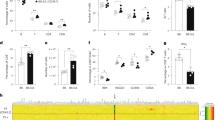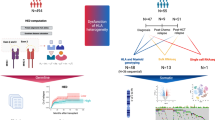Abstract
Models of the different disease patterns of cutaneous leishmaniasis can be established by infecting various inbred strains of mice with Leishmania tropica. The BALB/c strain is exceptionally susceptible in that the infection is dosage independent and inexorably progressive, terminating in cutaneous and fatal visceral metastasis1–3. This is largely determined by a single autosomal non-H–2-linked gene3, seemingly not identical to the well-characterized Lsh gene which determines innate susceptibility to systemic Leishmania donovani infection4,5. Although H–2-linked genetic influences are also detectable in the immune stage of both leishmanial infections3,6, they are relatively minor in the case of L. tropica. Thus, although progression of disease induced by lower infecting doses is slower in congeneic B ALB/K (H–2k) than in BALB/c or BALB/B (H–2b) mice, the eventual outcome is similar in all three3. This inability to control L. tropica infection seems to involve profound impairment of potentially curative cell-mediated immunity by the generation of a specific suppressor T-cell population7. With two other pathogens which infect mononuclear phagocytes, Listeria monocytogenes and Mycobacterium iepraemurium, differences in mouse strain susceptibility have been attributed to extrinsic factors regulating macrophage activity rather than to intrinsic gene expression within the cells themselves8,9. The relative strain susceptibility of mice to myxoviruses (determined by the dominant allele Mx) is also a genetic characteristic of their macrophages in vitro10. Nevertheless, radiation chimaeras exhibit the myxovirus resistance profile of the host despite near-total haematopoietic cell replacement, including donor macrophages which can still express their original susceptibility in vitro11. In contrast, the experiments described here indicate unequivocally that susceptibility to L. tropica in radiation chimaeras compatible at the major histocompatibility (H–2) locus is determined by the descendants of donor haematopoietic cells and not by host environmental factors.
This is a preview of subscription content, access via your institution
Access options
Subscribe to this journal
Receive 51 print issues and online access
$199.00 per year
only $3.90 per issue
Buy this article
- Purchase on Springer Link
- Instant access to full article PDF
Prices may be subject to local taxes which are calculated during checkout
Similar content being viewed by others
References
Kellina, O. I. Med. Parasit. 42, 279–285 (1973).
Handman, E., Ceredig, R. & Mitchell, G. F. Aust. J. exp. Biol. med. Sci. 57, 9–29 (1979).
Howard, J. G., Hale, C. & Chan-Liew, W. L. Parasite immunology (in the press).
Bradley, D. J. Clin. exp. Immun. 30, 130–140 (1977).
Bradley, D. J., Taylor, B. A., Blackwell, J., Evans, E. P. & Freeman, J. Clin. exp. Immun. 37, 7–14 (1979).
Blackwell, J., Freeman, J. & Bradley, D. Nature 283, 72–74 (1980).
Howard, J. G., Hale, C. & Liew, F. Y. J. exp. Med. 152, 594–607 (1980).
Kongshavn, P. A. L., Sadarangani, C. & Skamene, E. Cell. Immun. 53, 341–349 (1980).
Preston, P. M. Trans. R. Soc. trop. Med. Hyg. 73, 212–215 (1979).
Lindenmann, J., Deuel, E., Fanconi, S. & Haller, O. J. exp. Med. 147, 531–540 (1978).
Haller, O., Arnheiter, H. & Lindenmann, J. J. exp. Med. 150, 117–126 (1979).
Balner, H. Transplantation 1, 217–223 (1963).
Virolainen, M. J. exp. Med. 127, 943–952 (1968).
Onoé, K., Fernandes, G. & Good, R. A. J. exp. Med. 151, 115–132 (1980).
Korngold, R. & Sprent, J. J. exp. Med. 148, 1687–1698 (1978).
Purchase, H. G., Gilmour, D. G., Romero, C. H. & Okazaki, W. Nature 270, 61–62 (1977).
Hormaeche, C. E. Immunology 37, 329–332 (1979).
Author information
Authors and Affiliations
Rights and permissions
About this article
Cite this article
Howard, J., Hale, C. & Liew, F. Genetically determined susceptibility to Leishmania tropica infection is expressed by haematopoietic donor cells in mouse radiation chimaeras. Nature 288, 161–162 (1980). https://doi.org/10.1038/288161a0
Received:
Accepted:
Issue Date:
DOI: https://doi.org/10.1038/288161a0
This article is cited by
-
Th1/Th2 balance in infection
Springer Seminars in Immunopathology (1999)
Comments
By submitting a comment you agree to abide by our Terms and Community Guidelines. If you find something abusive or that does not comply with our terms or guidelines please flag it as inappropriate.



